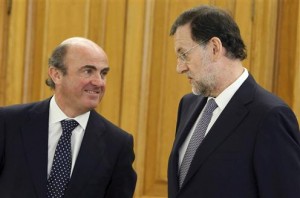
“It’s not a bailout…it’s a credit line with very favourable conditions.” (Luis de Guindos.)
“It’s a victory for the euro…If we hadn’t done what we have done in the past five months, the result would have been a bailout of the kingdom of Spain.” (Mariano Rajoy.)
You’d hardly imagine, from listening to Spain’s prime minister and his economy minister, that the country has joined the list of nations that are receiving rescue packages from the European Union. Offering up to €100 billion for a banking sector crippled by toxic assets is clearly a major step for the EU, although whether it’s the “victory” Mariano Rajoy talks about is still uncertain.
One thing the EU’s fourth bailout has confirmed is the Rajoy government’s unusual way of handling major developments. Luis de Guindos’s insistence at Saturday’s press conference that the bailout wasn’t a bailout has clearly convinced no one. But the fact that Rajoy was not there to field questions – or himself announce the biggest decision of his government so far – just looked plain strange.
But besides tying itself up in knots in order to avoid using the word “bailout”, the government must also be asking itself if this rescue will work. Throughout this debt crisis, Spain has distinguished itself by having lower public debt than most of its neighbours. But the country’s soaring borrowing costs in recent months have put pressure on that debt burden. A new loan that could total €100 billion will do more of the same.
As New York-based blogger Felix Salmon writes: “all the money for bailing out Spain’s banks is immediately going to become Spanish sovereign debt. And that’s not good, for anyone worried about the Spanish fiscal situation.”
Clearly the alternative to the bailout (ie: no bailout) was no longer viable and like many chapters in the euro-zone crisis, this was simply a case of the inevitable being denied and drawn out, before then coming to pass.
When Asian and European markets responded positively on Monday morning to the Spanish rescue, Rajoy’s “victory for the euro” comment started to look rather less fanciful. But as Spain’s risk premium started to climb once again over the 500-point mark later in the day, old fears and questions that have plagued the EU, and particularly the Rajoy government, started to raise their head again: Haven’t we done enough? Could more than €100 billion be necessary?
With much of the detail of the bailout itself still yet to emerge, rumours are already flying in Spain about what exactly the country will have to do in return for the loan, and whether macroeconomic policy will indeed remain untouched, as the government claims.
On Sunday, Rajoy justified his decision to fly to Poland to watch Spain play Italy in the European Championships by saying that the situation “is resolved”. But with Spain’s banks still facing the mammoth task of restructuring and the markets yet to show they are convinced, that looks anything but the case.
Leave a Reply
You must be logged in to post a comment.